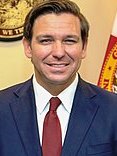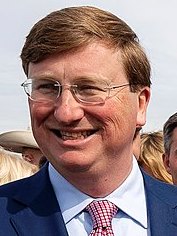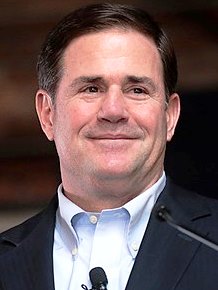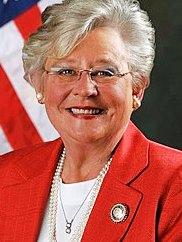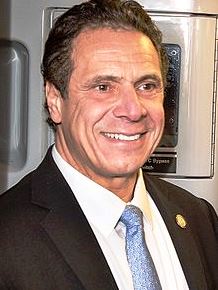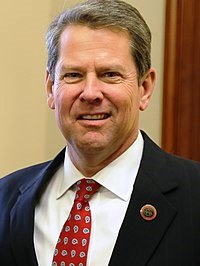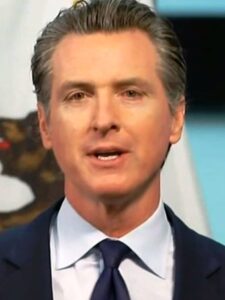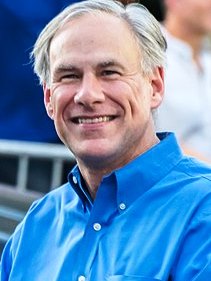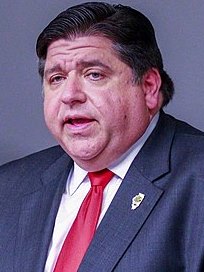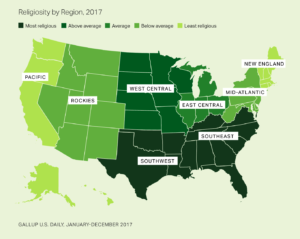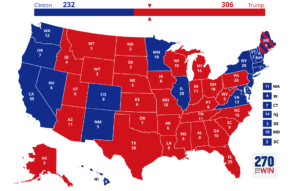‘2020’ Category
» posted on Thursday, September 3rd, 2020 by Linda Lou Burton
The Lone Ranger
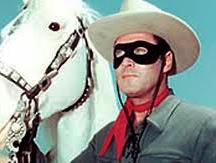 September 3, 2020, Linda Lou Burton posting from Little Rock, Arkansas – The Lone Ranger’s mask, according to movie hype, was designed to protect his identity. I went to many Lone Ranger movies in the early 50s, and even as a popcorn-munching 10-year-old, I knew I’d recognize my idol whether he was masked or not, even if he showed up without his trusty white steed. It did make him rather mysterious and handsome, but that was all. If he believed that little mask did what it was “supposed” to do, he was deluded.
September 3, 2020, Linda Lou Burton posting from Little Rock, Arkansas – The Lone Ranger’s mask, according to movie hype, was designed to protect his identity. I went to many Lone Ranger movies in the early 50s, and even as a popcorn-munching 10-year-old, I knew I’d recognize my idol whether he was masked or not, even if he showed up without his trusty white steed. It did make him rather mysterious and handsome, but that was all. If he believed that little mask did what it was “supposed” to do, he was deluded.
I’m afraid some of us are equally deluded with regard to COVID-19 masks. Count me in that corner. I have been of the notion that the mask was to protect ME from being pelted with virus-laden droplets spewed out from some virus carrier. I was thinking that my mask would keep those droplets from entering my breathing apparatus, and keep me safe from harm. I thought the mask, like the seatbelt in my car, was all about ME.
The masks we are advised, and in some instances, MANDATED to wear are to keep US from infecting other people. And if they are not the right KIND of masks, worn and handled the right WAY, they are no more effective than that little black strip around the eyes that was meant to hide the Lone Ranger’s identity. Coronavirus Masks are meant to protect the rest of the world from the WEARER.
And I am distressed to tell you that the Centers for Disease Control, which we hark to here in the United States, and the World Health Organization (note the word WORLD) do NOT offer the same advice with regard to what kind of masks actually STOP any virus-laden droplets from spewing out into the world when we cough, or sneeze.
The Centers for Disease Control recommends a two layer mask. Go to THIS SITE to read their advice. It’s good advice, but is it enough?
https://www.cdc.gov/coronavirus/2019-ncov/prevent-getting-sick/about-face-coverings.html
The Centers for Disease Control is a USA government entity that is part of the US Department of Health and Human Services. The Director is Robert Redfield, MD, who has served since March 26, 2018. He was appointed to the post by Donald Trump, after Trump’s first appointee, Tom Price, resigned over controversy regarding his use of private jets and charter flights at taxpayer expense.
The World Health Organization recommends a three-layer mask. Go to THIS SITE to read why “three layers are more effective than two.”
virus-2019/advice-for-public/when-and-how-to-use-masks
The World Health Organization (WHO) is a specialized agency of the United Nations responsible for international public health. The WHO Constitution states its main objective as “the attainment by all peoples of the highest possible level of health.” It is headquartered in Geneva, Switzerland, with six semi-autonomous regional offices and 150 field offices worldwide.
The Trump administration has begun the process of withdrawing the United States from the World Health Organization, effective July 6, 2021, via a letter sent to United Nations Secretary General António Guterres. It is not clear whether Trump can pull the United States out of the organization and withdraw funding without Congress. Democratic lawmakers have vowed to push back; Sen. Robert Menendez , the ranking Democrat on the Senate Foreign Relations Committee, commented that such an action “leaves Americans sick & America alone.” Joe Biden has commented that, if elected, he would immediately rejoin the organization and “restore our leadership on the world stage, because Americans are safer when America is engaged in strengthening global health.”
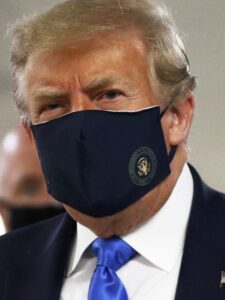 TO DATE, the number of COVID-19 cases in the United States accounts for 23% of all cases in the world. Why is that?
TO DATE, the number of COVID-19 cases in the United States accounts for 23% of all cases in the world. Why is that?
Masking is obviously NOT enough – at least incorrect masks, worn incorrectly. It behooves us to know what we can do to protect ourselves, and others. One thing for sure – Trump’s resistance to wearing a mask himself because he “didn’t want to look like the Lone Ranger” was a fruitless worry on his part. He does not look like the Lone Ranger, no matter how hard he tries to separate the United States from the rest of the world.
» posted on Wednesday, September 2nd, 2020 by Linda Lou Burton
Hair Today
 September 2, 2020, Linda Lou Burton posting from Little Rock, Arkansas – It makes sense that Donald would comment on Nancy getting her hair blow dried; something a big hair guy would be sure to notice. Hard to tell if the hullabaloo is about Nancy walking down a hallway with wet hair and no mask, or the idea that blow driers in and of themselves are deadly. Geez, it’s hard to look pretty, with this virus thingy making a haircut so dangerous. I decided to check it out. What evil lurks in the hair salon these days? Beauty Parlor Gossip was the worst thing about such an environment in years past; Eudora Welty claimed to get some of her best story ideas from an afternoon under the drier. One of her short stories, The Petrified Man, is actually set in a
September 2, 2020, Linda Lou Burton posting from Little Rock, Arkansas – It makes sense that Donald would comment on Nancy getting her hair blow dried; something a big hair guy would be sure to notice. Hard to tell if the hullabaloo is about Nancy walking down a hallway with wet hair and no mask, or the idea that blow driers in and of themselves are deadly. Geez, it’s hard to look pretty, with this virus thingy making a haircut so dangerous. I decided to check it out. What evil lurks in the hair salon these days? Beauty Parlor Gossip was the worst thing about such an environment in years past; Eudora Welty claimed to get some of her best story ideas from an afternoon under the drier. One of her short stories, The Petrified Man, is actually set in a  beauty parlor. Lots of gossip in that one. Yes, back before Twitter, we relied on our beauty parlors to spread tales.
beauty parlor. Lots of gossip in that one. Yes, back before Twitter, we relied on our beauty parlors to spread tales.
But back to our modern hair salons, and the dangers they may, or may not, present for us. Prevention magazine recently interviewed infectious disease specialist Michael Ben-Aderet, MD, about salon safety tips and recommendations in the age of COVID-19. The article appears at a time when many states are easing restrictions and businesses like hair salons are reopening.
“The number one-way coronavirus spreads is through respiratory droplets from someone who is sick,” said Ben-Aderet, explaining the virus spreads the same way in salons as it does anywhere – making it increasingly more important that sick people do not enter salons. “One way to do this is to screen clients before appointments to make sure those who are sick reschedule if they have fever, cough, or shortness of breath.” But many people want to know what happens if someone sick does enter a salon. Can products and tools like a blow dryer spread COVID-19?
“A blow dryer does have the potential to spread contaminated air around a room,” said Ben-Aderet. “But again, there needs to be an infected person around. Unless someone coughs into a hair dryer and that spreads the droplets, it’s very unlikely.” As for the blow dryer itself, Ben-Aderet says it’s “unlikely for a hair dryer to be contaminated with coronavirus.” He does explain, however, that while viruses can’t grow on surfaces, they can persist on certain surfaces for a particular amount of time, making it imperative that each salon is cleaned and disinfected after each client. “Touching a surface that is contaminated with secretions or mucus membranes from a sick individual and then touching your face can make you sick,” said Ben-Aderet. “It’s important to remember that viruses need to grow in a person.”
 So there you have it. A sick PERSON is the dangerous thing. And if not yet obviously sick, A VIRUS CARRIER. If nobody is hauling the virus around on their body, and coughing and touching things with their virus-contaminated droplets, or hands they just wiped against their nose, there is no virus to get anybody else sick. And the notion of “sick people” spreading things to other people is true for ordinary colds, the flu, and lots of other stuff that people transmit from one to another. It’s rude to take your sick self out and put your germs off on somebody else. Don’t do it!
So there you have it. A sick PERSON is the dangerous thing. And if not yet obviously sick, A VIRUS CARRIER. If nobody is hauling the virus around on their body, and coughing and touching things with their virus-contaminated droplets, or hands they just wiped against their nose, there is no virus to get anybody else sick. And the notion of “sick people” spreading things to other people is true for ordinary colds, the flu, and lots of other stuff that people transmit from one to another. It’s rude to take your sick self out and put your germs off on somebody else. Don’t do it!
We’re advised to wear masks when we do go out now, so if we have that Virus Thingy, we don’t spread it. This is a dangerous proviso – having a mask dangling around your neck and not properly positioned, or made of the wrong material, or not kept clean, is as bad as not having one at all. Also, RELYING on a mask as your ultimate protection is foolhardy. Look at these videos showing how far DROPLETS can travel THROUGH a mask!
https://www.youtube.com/watch?v=evATiHUejxg&feature=youtu.be
Tomorrow: Masks Better Than Even The Lone Ranger Wore
» posted on Tuesday, September 1st, 2020 by Linda Lou Burton
That Virus Thingy
September 1, 2020, Linda Lou Burton posting from Little Rock, Arkansas – Six months have passed since we really started counting “that virus thingy.” I check the US stats on the Centers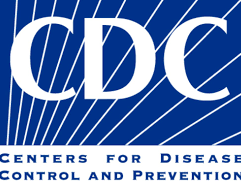 for Disease Control website every week; so far no US state or territory has had a week go by with NO new cases. Except for American Samoa, bless their peaceful, well-isolated hearts. Today I took a worldwide look – the World Health Organization has an excellent site and really good advice. It’s vitally important to track what is going on in our own neighborhood, but I believe it is equally important to track what is happening beyond our borders. Compare – how are they managing? How are we, in the US?
for Disease Control website every week; so far no US state or territory has had a week go by with NO new cases. Except for American Samoa, bless their peaceful, well-isolated hearts. Today I took a worldwide look – the World Health Organization has an excellent site and really good advice. It’s vitally important to track what is going on in our own neighborhood, but I believe it is equally important to track what is happening beyond our borders. Compare – how are they managing? How are we, in the US?
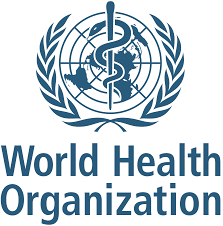 As of the beginning of September, 2020, the World Health Organization shows 25,541,380 cases of COVID-19 reported worldwide; 852,000 deaths. If we want to compare that death count with the population of cities of equal size – we could say that EVERYBODY in Indianapolis, Indiana is dead now. Or, Seattle, Washington. Dead. No living, breathing persons left in those cities. When you look at it THAT way, it seems like a lot of deaths, doesn’t it? Other cities in the US that have populations in the 800,000 range are Charlotte, North Carolina; San Francisco, California, Columbus, Ohio; Forth Worth, Texas. Imagine them gone! Imagine a dystopian horror tale, such as Peter Heller’s The Dog Stars
As of the beginning of September, 2020, the World Health Organization shows 25,541,380 cases of COVID-19 reported worldwide; 852,000 deaths. If we want to compare that death count with the population of cities of equal size – we could say that EVERYBODY in Indianapolis, Indiana is dead now. Or, Seattle, Washington. Dead. No living, breathing persons left in those cities. When you look at it THAT way, it seems like a lot of deaths, doesn’t it? Other cities in the US that have populations in the 800,000 range are Charlotte, North Carolina; San Francisco, California, Columbus, Ohio; Forth Worth, Texas. Imagine them gone! Imagine a dystopian horror tale, such as Peter Heller’s The Dog Stars  (2012); a world where the unexpected happened – a flu pandemic struck – and life on the planet had to adjust to “what is.” While I’m a believer in Positive Thinking, I’m also a believer in being well-informed. And approaching life in ways that are reasonable, and not based on impatience to “get back to normal, now!” Like, opening schools. Sure, kids are getting a sucky education right now. Sure, parents are sick and tired of having to manage and monitor their children’s schooling from home. Sure – well the issue is ablaze in arguments and accusations and vastly different proposals. Politics involved. What is the best solution? Start with facts.
(2012); a world where the unexpected happened – a flu pandemic struck – and life on the planet had to adjust to “what is.” While I’m a believer in Positive Thinking, I’m also a believer in being well-informed. And approaching life in ways that are reasonable, and not based on impatience to “get back to normal, now!” Like, opening schools. Sure, kids are getting a sucky education right now. Sure, parents are sick and tired of having to manage and monitor their children’s schooling from home. Sure – well the issue is ablaze in arguments and accusations and vastly different proposals. Politics involved. What is the best solution? Start with facts.
Here are the numbers broken down by sections of the world, and then the US.
World Health Organization Statistics – Number of Cases Reported Worldwide as of September 1, 2020
- Americas – 13,469,747
- SE Asia – 4,318,281
- Europe – 4,225,328
- Eastern Mediterranean – 1,939,204
- Africa – 1,056,120
- Western Pacific – 501,959
- TOTAL WORLDWIDE – 25,541,380
Of the Americas, that’s both North and South, let’s look at what is happening just in the United States. We’ve got the most cases of any American country — 6,004,443 COVID-19 cases reported to date; 183,050 deaths from the virus. That “death” total kills off everybody in Little Rock, just about! The US numbers are big, and continue to get bigger. Over the next month, I’ll be looking at what other countries in the world are doing to combat a pandemic that is “sure ‘nough” real, and how they are keeping their citizens safe.
Meanwhile, wash your hands, keep your chin up (with MASK intact!), and if you happen to live in any of the states below, get in touch with your governor because your state is leading the pack this week, an honor you don’t want.
US States With Highest Percent of Population Diagnosed With COVID-19 as of September 1
- Louisiana – 3.2%, Governor John Bel Edwards, Democrat
- Florida – 2.87%, Governor Ronald Dion DeSantis, Republican
- Mississippi – 2.81%, Governor Jonathon Tate Reeves, Republican
- Arizona – 2.77%, Governor Douglas Anthony Ducey, Republican
- Alabama – 2.57%, Governor Kay Ellen Ivey, Republican
US States With Greatest Numbers of COVID-19 Cases Diagnosed as of September 1
- California – 704,485, Governor Gavin Christopher Newsom, Democrat
- Florida – 616,629, Governor Ronald Dion DeSantis, Republican
- Texas – 612,969, Governor Gregory Wayne Abbott, Republican
- New York – 435,783, Governor Andrew Mark Cuomo, Democrat
- Georgia – 270,471, Governor Brian Porter Kemp, Republican
US States With Most New Cases Diagnosed in One Week as of September 1
- California – 40,416, Governor Gavin Christopher Newsom, Democrat
- Texas – 35,432, Governor Gregory Wayne Abbott, Republican
- Florida – 22,342, Governor Ronald Dion DeSantis, Republican
- Georgia – 16,522, Governor Brian Porter Kemp, Republican
- Illinois – 15,130, Governor Jay Robert “J. B.” Pritzker, Democrat
» posted on Sunday, August 23rd, 2020 by Linda Lou Burton
Sunday Morning Sidewalk
 Linda Lou Burton posting from Little Rock, Arkansas – It’s Sunday. Did you go to church today? Or do you put yourself in the SBNA column, that is, Spiritual But Not Affiliated? “Organized religion” has been on a worldwide downtrend in recent years; reasons are not crystal-clear, perhaps there is simply more poll-taking. Freedom of Religion, and its first cousin, Freedom of Speech, are the Top-Valued basics we brag about most here in the US of A. When Kayla and Sam and I visited the National Archives on our recent NDI RTW, one of the things we saw in the Rotunda for the Charters of Freedom was The Bill of Rights, adopted December 15, 1791. And the very FIRST Amendment on that list reads like this:
Linda Lou Burton posting from Little Rock, Arkansas – It’s Sunday. Did you go to church today? Or do you put yourself in the SBNA column, that is, Spiritual But Not Affiliated? “Organized religion” has been on a worldwide downtrend in recent years; reasons are not crystal-clear, perhaps there is simply more poll-taking. Freedom of Religion, and its first cousin, Freedom of Speech, are the Top-Valued basics we brag about most here in the US of A. When Kayla and Sam and I visited the National Archives on our recent NDI RTW, one of the things we saw in the Rotunda for the Charters of Freedom was The Bill of Rights, adopted December 15, 1791. And the very FIRST Amendment on that list reads like this:
Congress shall make no law respecting an establishment of religion, or prohibiting the free exercise thereof; or abridging the freedom of speech, or of the press; or the right of the people peaceably to assemble, and to petition the Government for a redress of grievances.
Forty-five words that pack a heck of a lot of power. The first thing I get from that part about “religion” is simple: I can choose which religion I want and I can choose not to practice a religion at all if that is my wish. And from the part about “speech,” I understand that I can say, or not say, whatever I please, except, that has been amended a bit to say “don’t tell lies about other people and don’t use filthy language that distresses other people.” Which, of course, has led to many other amendments and arguments about just what “filthy language” IS, and what distresses others. A can of worms there. And sometimes, NOT saying something is considered a real faux pas.
I was thinking about that this morning when I read the story that came out of the Democratic Convention last week about the Pledge of Allegiance. The Democrats were accused of leaving “under God” out of the Pledge. And then AP Fact Check came forward to explain: The Central Programming of the Convention featured the entire Pledge, complete with “under God.” However, the Muslim Delegates and Allies Assembly and the LGBTQ Caucus meeting on Tuesday chose not to include those words. That was not part of the prime-time broadcast.
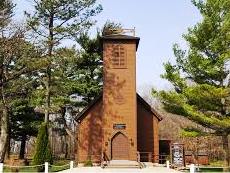 That’s a good example of a nitpick. Because the truth of the matter is – we have the right to speak, or not; and we have the right to be religious (whatever that means) or not, but we will be judged on our choices. Yes, I can be a Wiccan or an atheist or a born-again Christian, but along with that choice comes a passel of attitudes that will be formed about me, depending on
That’s a good example of a nitpick. Because the truth of the matter is – we have the right to speak, or not; and we have the right to be religious (whatever that means) or not, but we will be judged on our choices. Yes, I can be a Wiccan or an atheist or a born-again Christian, but along with that choice comes a passel of attitudes that will be formed about me, depending on  whether or not the other fellow is a Wiccan, or an atheist, or a born-again Christian (or Jew, or Muslim, or SBNA…..)
whether or not the other fellow is a Wiccan, or an atheist, or a born-again Christian (or Jew, or Muslim, or SBNA…..)
It’s the way our minds work. We categorize! And in fact, the choices people make DO speak to who they are, and how they think, unless they’re just sheep following the most popular shepherd. No doubt the revelation that VP Candidate Kamala Harris attended  both a black Baptist church and a Hindu temple growing up, and is now married to a Jewish man, will cause some heads to spin. Labels will be stuck to her forehead! And golly gee, look at VP Candidate Mike Pence – he grew up in a Catholic home, then in college he became a born-again Christian and joined a mega-church. So he now identifies as a born-again Catholic, who adheres to the Billy Graham belief that men and women who are not married should not be alone together. And he’s on the ticket with a man who, well, you know that story.
both a black Baptist church and a Hindu temple growing up, and is now married to a Jewish man, will cause some heads to spin. Labels will be stuck to her forehead! And golly gee, look at VP Candidate Mike Pence – he grew up in a Catholic home, then in college he became a born-again Christian and joined a mega-church. So he now identifies as a born-again Catholic, who adheres to the Billy Graham belief that men and women who are not married should not be alone together. And he’s on the ticket with a man who, well, you know that story.
Will our current tickets have a broad enough appeal to pull in almost EVERYBODY? Protestants & Catholics & People Who Once Were Catholics & Jews & SBNAs? Others? Will that get the vote up from the lousy 56% in the 2016 election?
Here are the answers people gave in a 2014 national survey when asked what their “religious preferences” are. There’s a map at the end. (No Religion includes the SBNAs)
United States Percent of Population Religious Practice
- Protestant 46.5%
- Catholic 20.8%
- Mormon 1.6%
- Non-Christian Religion (Islam, Buddhist, Hindu, other) 5.9%
- No Religion 22.8%
Then I broke it down into the top 5 states in each of those categories for a sense of “lay of the land” in case you are campaigning.
Protestant
- Alabama 78%
- Mississippi 77%
- Tennessee 73%
- West Virginia 70%
- Arkansas 70%
Catholic
- Rhode Island 42%
- New Mexico 34%
- New Jersey 34%
- Massachusetts 34%
- Connecticut 33%
Mormon
- Utah 55%
- Idaho 19%
- Wyoming 9%
- Arizona 5%
- Alaska 5%
Non Christian Religion (Islam, Buddhist, Hindu, other)
- New Jersey 14%
- New York 12%
- Hawaii 10%
- District of Columbia 9%
- California 9%
- Massachusetts 9%
No Religion
- Vermont 37%
- New Hampshire 36%
- Washington 32%
- Massachusetts 32%
- Alaska 31%
- Oregon 31%
- Maine 31%
Are you surprised?
» posted on Saturday, August 22nd, 2020 by Linda Lou Burton
The Better To Hear?
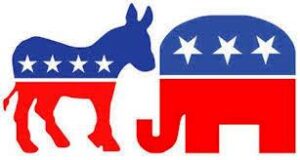 Linda Lou Burton posting from Little Rock, Arkansas – I got curious, and went on a search. When, I wondered, did the Democrats and Republicans begin using donkeys and elephants as party symbols? And more puzzling, WHY? A donkey, aka, JACKASS, with an annoying bray? And a big lumbering elephant who would surely eat you out of house and home if you let it in?
Linda Lou Burton posting from Little Rock, Arkansas – I got curious, and went on a search. When, I wondered, did the Democrats and Republicans begin using donkeys and elephants as party symbols? And more puzzling, WHY? A donkey, aka, JACKASS, with an annoying bray? And a big lumbering elephant who would surely eat you out of house and home if you let it in?
Turns out the story actually does begin with somebody calling somebody a jackass. Andrew Jackson, back in the election of 1828, was depicted as being “stubborn as a jackass” and Andrew just flat turned it around and, with a donkey as a mascot, beat out John Quincy Adams! Remember, Adams became president in 1824, though Jackson had won the popular vote. But Jackson tried it again, and whupped Adams you-know-what. It was a landslide.
The “mascot” idea didn’t really catch on until the mid-1800’s however, and I found some interesting examples of political cartoons. The first I’ll share, with full credit to American Antiquarian, explains what “seeing the elephant” generally referred to. Citation: “Jeff. Sees the Elephant,” The News Media and the Making of America, 1730-1865, https://americanantiquarian.org/earlyamericannewsmedia/items/show/120
Jeff. Sees the Elephant
This color lithograph published by E. B. & E. C. Kellogg of Hartford, Connecticut, and George Whiting of New York City dates from 1861 or 1862. It is believed to be the first time that the elephant and donkey appear together depicting the Republican and Democratic parties. The phrase “to see the elephant” was a common expression in the mid-nineteenth century and often appears in descriptions of both the gold rush and the Civil War. It is thought to originate with the circus. The large mammals such as lions and elephants were the climax of the circus experience and always appeared toward the end of the performances. When one had “seen the elephant” then one had seen the entire show. The term then gradually became synonymous with experiencing or” seeing it all.”
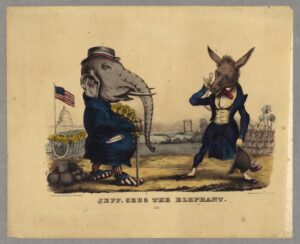 In this image the elephant bedecked in formal attire with accessories festooned with stars and stripes and the U.S. Constitution in his pocket represents the Union. The cannon barrels protruding from his waistcoat, and the multitude of even more cannon and cannon balls behind him, represent the great military prowess of the Northern states. Eventually Abraham Lincoln (1809-65) took on the elephant as his mascot. By his reelection campaign in 1864, trunks and tusks were used in his campaign materials and “the elephant is coming” became his slogan. Republicans have been associated with elephants ever since.
In this image the elephant bedecked in formal attire with accessories festooned with stars and stripes and the U.S. Constitution in his pocket represents the Union. The cannon barrels protruding from his waistcoat, and the multitude of even more cannon and cannon balls behind him, represent the great military prowess of the Northern states. Eventually Abraham Lincoln (1809-65) took on the elephant as his mascot. By his reelection campaign in 1864, trunks and tusks were used in his campaign materials and “the elephant is coming” became his slogan. Republicans have been associated with elephants ever since.
This humorous image also contains Jefferson Davis (1808-89) as a donkey, peering through a monocle at the elephant and his enormous quantity of arms and armaments. Behind him is an army of “jackasses” carrying pitchforks, rakes, brooms, and scythes, which are clearly no match for the North’s cannon. The gallows in the center background of the image portends a bleak future for the Confederacy. Jefferson Davis was a lifelong Democrat, having served as a U. S. representative and senator before becoming president of the Confederacy after the South seceded.
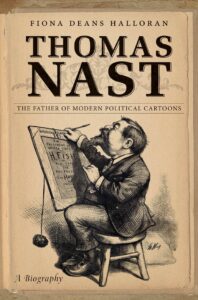 A fellow named Thomas Nast (1840 – 1902), a German-born American caricaturist, is considered the “Father of American Political Cartoons.” He was associated with Harper’s Weekly, and popularized the donkey-elephant symbols in his work. In general, his political cartoons supported American Indians and Chinese Americans. He advocated the abolition of slavery, opposed racial segregation, and deplored the violence of the Ku Klux Klan. Harper’s Weekly, and Nast, played an important role in the election of Abraham Lincoln in 1864, and Ulysses S Grant in 1868 and 1872.
A fellow named Thomas Nast (1840 – 1902), a German-born American caricaturist, is considered the “Father of American Political Cartoons.” He was associated with Harper’s Weekly, and popularized the donkey-elephant symbols in his work. In general, his political cartoons supported American Indians and Chinese Americans. He advocated the abolition of slavery, opposed racial segregation, and deplored the violence of the Ku Klux Klan. Harper’s Weekly, and Nast, played an important role in the election of Abraham Lincoln in 1864, and Ulysses S Grant in 1868 and 1872.
Clifford Berryman (1869 – 1949) was another influential political cartoonist; he worked with both the Washington Post and Washington Star. He drew thousands of cartoons commenting on American presidents, lampooning both of the Roosevelts and Harry Truman. 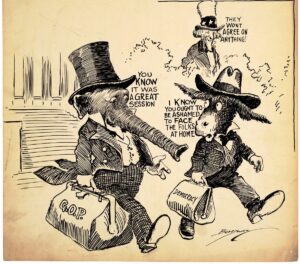 A Pulitzer Prize winner, his cartoons are in the National Archives, and the Library of Congress today.
A Pulitzer Prize winner, his cartoons are in the National Archives, and the Library of Congress today.
I found hundreds of donkey-elephant images during my search – they seem to be handy critters for “poking fun” or making serious accusations in a clever, right-to-the-point manner. The DEFINITION of each animal didn’t go far in explaining how they keep winding up on bumper stickers every four years though:
- Donkey: a domesticated hoofed mammal of the horse family with long ears and a braying call, used as a beast of burden; an ass.
- Elephant: a heavy plant-eating mammal with a prehensile trunk, long curved ivory tusks, and large ears, native to Africa and southern Asia; the largest living land animal.
Then I thought of PETA
PETA had been thinking about it too, and published a piece about it. In a showdown, which real animal would win? PETA called it a tie. https://www.peta.org/blog/elephants-vs-donkeys-win/
- Physical prowess: Elephants are active for 18 hours a day and can travel up to 30 miles a day. Donkeys can run up to 30 miles per hour and are sure-footed on rocky mountain crags.
- Compassion: Elephants will pitch in to help a mother elephant rescue her drowning baby. Donkeys are affectionate and patient with children.
- Beauty: Standing up to 13 feet tall with trunks that can reach for 7 feet, elephants make a majestic sight. Donkeys are beautiful with soft coats of fawn, chocolate, red, or black fur and a graceful gait.
- Intelligence: Elephants figured out a shortcut researchers hadn’t thought of in an experiment to see if they could work together, both pulling opposite ends of a rope, in order to move food close to them. Donkeys are smart too; companion donkeys answer to their names, go for walks off leash, and can even learn to pull carts through obstacle courses.
- Enjoying leisure time: Elephants like to cool off by using their trunks to spray water all over their bodies. Donkeys like to roll on their backs in the grass or dirt and love receiving treats and ear rubs.
One thing is clear. Both animals have big ears. The better to hear you with?
» posted on Friday, August 21st, 2020 by Linda Lou Burton
Who Counts?
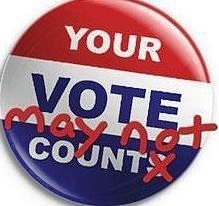 Linda Lou Burton posting from Little Rock, Arkansas – Interesting, isn’t it, that women fought so long and hard to be allowed to vote, but still must live in the right state for their vote to count. That’s true for men too! If you favor a Democrat, but live in a state full of Republicans, your vote isn’t worth the paper it’s printed on. And vice versa. In fact, you don’t actually vote for a CANDIDATE at all, though political campaigns are designed to appeal directly to the individual, coddling us with love and promises, if we vote for THEM.
Linda Lou Burton posting from Little Rock, Arkansas – Interesting, isn’t it, that women fought so long and hard to be allowed to vote, but still must live in the right state for their vote to count. That’s true for men too! If you favor a Democrat, but live in a state full of Republicans, your vote isn’t worth the paper it’s printed on. And vice versa. In fact, you don’t actually vote for a CANDIDATE at all, though political campaigns are designed to appeal directly to the individual, coddling us with love and promises, if we vote for THEM.
Once our vote is cast, however, it actually starts a ride through the maze known as the Electoral College, and if you recollect, five times since 1788 a candidate has won the popular vote but lost the election.
- Andrew Jackson in 1824 had 38,149 more votes than John Quincy Adams, but lost.
- Samuel Tilden (Dem) in 1876 had 254,235 more votes than Rutherford B Hayes (Rep), but lost.
- Grover Cleveland (Dem) in 1888 had 90,596 more votes than Benjamin Harrison (Rep), but lost.
- Al Gore (Dem) in 2000 had 543,895 more votes than George W Bush (Rep), but lost.
- Hillary Clinton (Dem) in 2016 had 2,868,686 more votes than Donald J Trump (Rep), but lost.
I’m sure you’ve got this memorized from Civics 101 in 6th grade, but just in case the details have gotten fuzzy, here is where your vote goes. Established in Article II, Section 1 of the US Constitution, the Electoral College is the formal body that elects the President and Vice President of the United States. Each state has as many “electors” in the Electoral College as it has Representatives and Senators in the United States Congress, and the District of Columbia has three electors. When voters go to the polls in a Presidential election, they actually are voting for the slate of electors vowing to cast their ballots for that ticket in the Electoral College.
Got that? You are voting for Electors.
Most states require that all electoral votes go to the candidate who receives the plurality in that state. After state election officials certify the popular vote of each state, the winning slate of electors meet in the state capital and cast two ballots—one for Vice President and one for President. Electors cannot vote for a Presidential and Vice Presidential candidate who both hail from an elector’s home state.
But not every state is the same.
Maine and Nebraska employ a “district system” in which two at-large electors vote for the state’s popular plurality and one elector votes for each congressional district’s popular plurality. In the November 2, 2004 election, Colorado voters rejected a “proportional system” in which electors would vote proportionally based on the state’s popular vote.
The District of Columbia and 26 states “bind” their electors to vote for their promised candidate, via a number of methods including oaths and fines. Though still rare, electors more commonly changed their vote in the 19th century—particularly on the vote for Vice President. Such “faithless electors” have never decided a Presidency however.
There has been one faithless elector in each of the following elections: 1948, 1956, 1960, 1968, 1972, 1976, and 1988. A blank ballot was cast in 2000. In 2016, seven electors broke with their state on the presidential ballot and six did so on the vice presidential ballot.
Faithless Electors! But to continue – A Job You Wouldn’t Want
Since the mid-20th century, on January 6 at 1:00 pm before a Joint Session of Congress, the Vice President opens the votes from each state in alphabetical order. He passes the votes to four tellers—two from the House and two from the Senate—who announce the results. House tellers include one Representative from each party and are appointed by the Speaker. At the 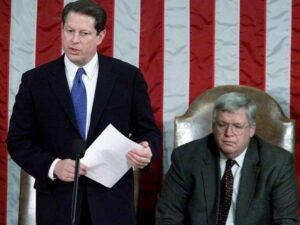 end of the count, the Vice President then declares the name of the next President. With the ratification of the 20th Amendment to the Constitution (and starting with the 75th Congress in 1937), the electoral votes are counted before the newly sworn-in Congress, elected the previous November. Sitting Vice Presidents John C. Breckinridge (1861), Richard Nixon (1961), Hubert Humphrey (1969), and Al Gore (2001) all had to announce that they had lost their own bid for the Presidency. https://history.house.gov/
end of the count, the Vice President then declares the name of the next President. With the ratification of the 20th Amendment to the Constitution (and starting with the 75th Congress in 1937), the electoral votes are counted before the newly sworn-in Congress, elected the previous November. Sitting Vice Presidents John C. Breckinridge (1861), Richard Nixon (1961), Hubert Humphrey (1969), and Al Gore (2001) all had to announce that they had lost their own bid for the Presidency. https://history.house.gov/
There have been a total of 165 instances of elector faithlessness as of 2016. The United States Constitution does not specify a notion of pledging; no federal law or constitutional statute binds an elector’s vote to anything. All pledging laws originate at the state level. In 2020, the Supreme Court ruled in Chiafalo v. Washington that states are free to enforce laws that bind electors to voting for the winner of the popular vote in their state.
Supporters of the Electoral College argue that it is fundamental to American federalism, that it requires candidates to appeal to voters outside large cities, increases the political influence of small states, preserves the two-party system, and makes the electoral outcome appear more legitimate.
Non-supporters would argue that the Electoral College places powers governing a national election within state boundaries and removes the ability of the individual to select their leader.
» posted on Thursday, August 20th, 2020 by Linda Lou Burton
Voting, and the Virus
Linda Lou Burton posting from Little Rock, Arkansas – As of August 20, the World Health Organization reports 22,536,278 cases of COVID-19 in the world. Of that, 5,511,793 cases are in the United States, a number which amounts to one quarter, that is 25% of the worldwide total. In case you’re wondering, the population of the United States is 5% of the world population. Just saying.
I find it difficult to keep up with the current hoopla about “who is doing what when” with regard to decisions about managing a pandemic on local ground; and even more hoopla about “how to have a secure vote” with regard to the upcoming presidential election. So the recent announcement about New Zealand’s decision to postpone a national election due to an upsurge in COVID-19 cases really caught my eye.
Action in New Zealand
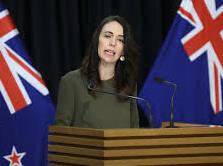 On Monday, August 17 Prime Minister Jacinda Ardern of New Zealand announced that the September national election would be delayed by four weeks as new virus cases spread across Auckland, making it difficult to campaign. Prime Minister Ardern, who has the sole authority to determine when people cast ballots, said she had consulted with all the major parties before delaying the vote, originally scheduled for September 19, to October 17. Ms Ardern called the decision a compromise that “provides sufficient time for parties to plan around the range of circumstances we could be campaigning under, for the electoral commission to prepare, and for voters to feel assured of a safe, accessible and critical election.”
On Monday, August 17 Prime Minister Jacinda Ardern of New Zealand announced that the September national election would be delayed by four weeks as new virus cases spread across Auckland, making it difficult to campaign. Prime Minister Ardern, who has the sole authority to determine when people cast ballots, said she had consulted with all the major parties before delaying the vote, originally scheduled for September 19, to October 17. Ms Ardern called the decision a compromise that “provides sufficient time for parties to plan around the range of circumstances we could be campaigning under, for the electoral commission to prepare, and for voters to feel assured of a safe, accessible and critical election.”
The shift keeps Election Day within the time frame allowed under the law — the latest possible date is November 21 — but it also highlights the national concern as a cluster of at least 58 new cases frustrates investigators, clears the streets of Auckland and suspends scheduled campaign events. Pressure on Ms Ardern and her Labour Party to change the date had been building over several days. A poll taken over the weekend showed that 60 percent of New Zealanders favored a delay. The leaders of other major parties also argued that the Level 3 lockdown in Auckland, the country’s largest city, prevented campaigning and would have made a free and fair election impossible on the original date.
I noted earlier, when on my NDI RTW visit to New Zealand, that their voting process is quite different from the US, where campaigning begins early and the media races to outdo itself by predicting, and announcing, results “before midnight.” I still recall my frustration in Seattle one year when I headed for the polls after work, only to hear “the winner declared” on the car radio. With our current Cell Phone Mentality, it’s a second-by-second race to get ahead of the game. I call it blather. Just saying.
From the New Zealand Electoral Commission webpage, I see today’s schedule for their 2020 General Election.
- Monday 17 August: Prime Minister announces new dates for the 2020 General Election
- Tuesday 18 August: Regulated period for election advertising expenses begins
- Sunday 6 September: Parliament dissolves
- Sunday 13 September: Writ Day – the Governor General formally directs us to hold the Election
- Thursday 17 September noon: Deadline for party secretaries to get their bulk nomination schedules and the party lists to us
- Friday 18 September noon: Deadline for electorate candidates to get their individual nomination forms to us
- Wednesday 30 September: Overseas voting starts
- Saturday 3 October: Advance voting starts
- Friday 16 October: Advance voting ends
- Friday 16 October midnight: The regulated period ends. All election and referendum advertising must end. Signs must be taken down by midnight.
- Saturday 17 October: Election day. Voters can vote from 9am to 7pm
- We’ll start releasing preliminary election results from 7pm on electionresults.govt.nz
- We won’t count referendum votes on election night
- Friday 30 October: We release the preliminary results for the referendums
- Friday 6 November: We declare the official results for the general election and referendums
- Thursday 12 November: Last day for the return of the writ
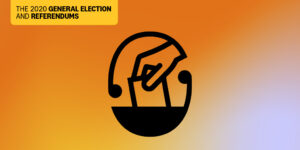 Easy peasy. Sit back and have a cup of tea. So, what will Ms Arden and the New Zealand government DO during this “delayed election” time? They will focus primarily on the virus. Health officials in New Zealand are scrambling to test thousands of workers at airports and other points of entry, along with quarantine facilities and a frozen food warehouse, to try to determine how the virus re-emerged last week.
Easy peasy. Sit back and have a cup of tea. So, what will Ms Arden and the New Zealand government DO during this “delayed election” time? They will focus primarily on the virus. Health officials in New Zealand are scrambling to test thousands of workers at airports and other points of entry, along with quarantine facilities and a frozen food warehouse, to try to determine how the virus re-emerged last week.
New Zealand’s election is far from the first to be postponed because of the pandemic. The International Foundation for Electoral Systems reports as of 08/20/2020 that 64 countries and eight territories have postponed a total of 109 election events due to COVID-19, ranging from local municipal elections to parliamentary and national events. The idea of delaying the US general election was floated by President Donald Trump, but it was shut down by members of Congress and his own party.
Everything you need to know about voting in New Zealand https://vote.nz/
Everything you need to know about voting in United States https://www.usa.gov/election
» posted on Wednesday, August 19th, 2020 by Linda Lou Burton
Women, And Politics
 August 19, 2020, Linda Lou Burton posting from Little Rock, Arkansas – Iceland, a parliamentary representative democracy at the northern end of the globe, was the first country to have a female president, Vigdís Finnbogadóttir, elected in 1980. It also has the world’s first female and openly gay head of government, Jóhanna Sigurðardóttir, who was elected prime minister in 2009. Iceland has had a woman as either president or prime minister for 20 of the last 36 years. In the 2016 parliamentary election covering 63 seats, 30 women were elected.
August 19, 2020, Linda Lou Burton posting from Little Rock, Arkansas – Iceland, a parliamentary representative democracy at the northern end of the globe, was the first country to have a female president, Vigdís Finnbogadóttir, elected in 1980. It also has the world’s first female and openly gay head of government, Jóhanna Sigurðardóttir, who was elected prime minister in 2009. Iceland has had a woman as either president or prime minister for 20 of the last 36 years. In the 2016 parliamentary election covering 63 seats, 30 women were elected.
New Zealand, a constitutional monarchy with a parliamentary system of government at the southern end of the globe, was the first country in the world in which all the highest offices were occupied by women, between March 2005 and August 2006: the Sovereign Queen Elizabeth II, Governor-General Dame Silvia Cartwright, Prime Minister Helen Clark, Speaker of the House Margaret Wilson, and Chief Justice Dame Sian Elias. Currently Queen Elizabeth II continues as Head of State, Governor-General is Dame Patsy Reddy, Prime Minister is Jacinda Arden and Chief Justice is Dame Helen Winkelmann.
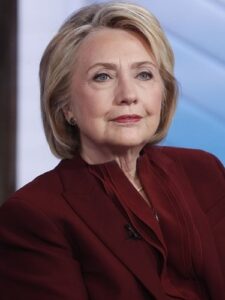 There has never been a female President or Vice-President in the United States, a federal democratic republic. There has been one female major party presidential nominee in US history: Democrat Hillary Clinton in 2016. She was the first woman nominated for president by a major party, the first woman to participate in a presidential debate, and the first to carry a state in a general election. She won the popular vote in 2016, receiving nearly 66 million votes to Donald Trump’s 63 million.
There has never been a female President or Vice-President in the United States, a federal democratic republic. There has been one female major party presidential nominee in US history: Democrat Hillary Clinton in 2016. She was the first woman nominated for president by a major party, the first woman to participate in a presidential debate, and the first to carry a state in a general election. She won the popular vote in 2016, receiving nearly 66 million votes to Donald Trump’s 63 million.
There have been three female major party vice presidential nominees: Democrat Geraldine Ferraro in 1984, on the ticket with Walter Mondale; Republican Sarah Palin in 2008, on the ticket with John McCain; and Democrat Kamala Harris in 2020, on the ticket with Joe Biden.
Voting
Both Iceland and New Zealand rank in the World List of Voter Participation Top 10 , each averaging about 76% turnout. Others in the TOP 10 are Belgium, Sweden, Denmark, Australia, South Korea, Netherlands, Israel, and Finland. The United States ranks in the World List of Voter Participation Bottom 10, with 56% in the 2016 presidential election. Others in the BOTTOM 10 are Estonia, Luxembourg, Slovenia, Chile, Japan, Latvia, Poland, Mexico, and Switzerland.
August 26, 2020, marks the 100th anniversary of the passage of The Nineteenth Amendment, giving women the right to vote in the United States after 72 years of the largest civil rights movement in the history of the world.
THE WOMAN SUFFRAGE TIMELINE as complied in the LIZ LIBRARY is available for your review; read of the events that have transpired since 1776, when Abigail Adams first spoke up for “the ladies.” http://www.thelizlibrary.org/suffrage/
I offer only a few highlights regarding women’s efforts to be ALLOWED to vote.
1700s
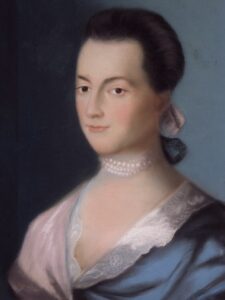 1776 Abigail Adams writes to her husband, John Adams, asking him to “remember the ladies” in the new code of laws. Adams replies the men will fight the “despotism of the petticoat.”
1776 Abigail Adams writes to her husband, John Adams, asking him to “remember the ladies” in the new code of laws. Adams replies the men will fight the “despotism of the petticoat.”- 1787 U.S. Constitutional Convention places voting qualifications in the hands of the states. Women in all states except New Jersey lose the right to vote.
1800s
- 1848 First Women’s Rights convention in Seneca Falls, New York. Equal suffrage proposed by Elizabeth Cady Stanton. After debate of so radical a notion, it is adopted.
- 1867 Fourteenth Amendment passes Congress, defining citizens as “male;” this is the first use of the word male in the Constitution. Kansas campaign for black and woman suffrage: both lose. Susan B. Anthony forms Equal Rights Association, working for universal suffrage. Suffrage Movement Divides Over Black v. Woman Suffrage.
- 1868 Fourteenth amendment ratified. Fifteenth Amendment passes Congress, giving the vote to black men. Women petition to be included but are turned down. Formation of New England Woman Suffrage Association. In New Jersey, 172 women attempt to vote; their ballots are ignored.
- 1870 Fifteenth Amendment ratified. The Grimke sisters and 42 other women attempt to vote in Massachusetts, their ballots are cast but ignored. Utah territory grants woman suffrage.
- 1878 Woman suffrage amendment first introduced in U.S. Congress.
- 1894 Despite 600,000 signatures, a petition for woman suffrage is ignored in New York.
1900s
- 1910 Washington (state) grants woman suffrage.
- 1911 California grants woman suffrage. In New York City, 3,000 march for suffrage.
- 1912 Teddy Roosevelt’s Progressive Party includes woman suffrage in their platform. Oregon, Arizona, and Kansas grant woman suffrage.
- 1913 Women’s Suffrage parade on the eve of Wilson’s inauguration is attacked by a mob. Alaskan Territory grants suffrage. Illinois grants municipal and presidential but not state suffrage to women.
- 1917 Beginning in January, NWP posts silent “Sentinels of Liberty” at the White House. In June, the arrests begin. Nearly 500 women are arrested, 168 women serve jail time, some are brutalized by their jailers. North Dakota, Indiana, Nebraska, and Michigan grant presidential suffrage; Arkansas grants primary suffrage. New York, South Dakota, and Oklahoma state constitutions grant suffrage.
- 1918 The jailed suffragists released from prison. Appellate court rules all the arrests were illegal. President Wilson declares support for suffrage. Suffrage Amendment passes U.S. House with exactly a two-thirds vote but loses by two votes in the Senate.
- 1919 In January, the NWP lights and guards a “Watchfire for Freedom.” It is maintained until the Suffrage Amendment passes U.S. Senate on June 4. The battle for ratification by at least 36 states begins.
And that battle ENDED in Tennessee on August 18, 1920, 100 years and 1 day ago. The story told by the guide when I toured the Nashville capitol was that young Harry T Burn from Niota gets credit for what happened that fateful day. At least, his mother does. The resolution had passed the Tennessee State Senate, but the vote in the House was close, in fact, on first vote it 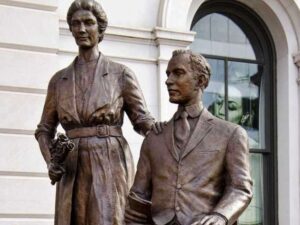 did not pass. Harry’s mother, Febb Ensminger Burn, a prominent businesswoman, sent her son a note. After lunch, he changed his vote, then HID from the angry crowds, but that one vote was all it took. Tennessee was the 36th and final state needed for ratification and the 19th Amendment became law August 26, 1920.
did not pass. Harry’s mother, Febb Ensminger Burn, a prominent businesswoman, sent her son a note. After lunch, he changed his vote, then HID from the angry crowds, but that one vote was all it took. Tennessee was the 36th and final state needed for ratification and the 19th Amendment became law August 26, 1920.
Women, and Politics. Interesting.
» posted on Tuesday, August 18th, 2020 by Linda Lou Burton
Potato Potatoe
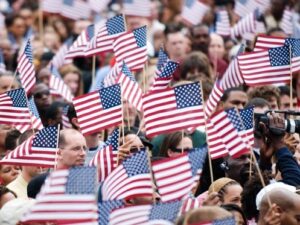 August 18, 2020, Linda Lou Burton posting from Little Rock, Arkansas – There is a political convention going on today, sort of a TV event. Watchers will get doused with speeches about issues, and positions, and planks and platforms and worthiness. When a person runs for political office, they wind up smack in the middle of the bullseye; everything they’ve ever done, or haven’t, is attacked, or praised, or tangled up with spin control and one-jump-ahead-itis. One must filter wisely. Lots of buzz about a female VP on the Democratic ticket. Lots
August 18, 2020, Linda Lou Burton posting from Little Rock, Arkansas – There is a political convention going on today, sort of a TV event. Watchers will get doused with speeches about issues, and positions, and planks and platforms and worthiness. When a person runs for political office, they wind up smack in the middle of the bullseye; everything they’ve ever done, or haven’t, is attacked, or praised, or tangled up with spin control and one-jump-ahead-itis. One must filter wisely. Lots of buzz about a female VP on the Democratic ticket. Lots 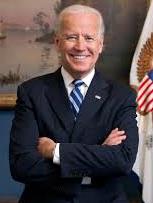 of buzz about AGE too. Something I notice myself, being 81. I did a little research, on that matter, and others.
of buzz about AGE too. Something I notice myself, being 81. I did a little research, on that matter, and others.
AGE. Assuming Joe Biden and Kamala Harris get through the convention as The Democratic Candidates for 2020, and assuming that Donald Trump and Mike Pence get through next week’s convention as The Republican Candidates for 2020, here are their birthdates and how their ages stack up, oldest to youngest. See how old they will be on Inauguration Day, January 20, 2021 and again in 2025.
- 1942, November 11 – Joe Biden 78-82
- 1946, June 14 – Donald Trump 74-78
- 1959, June 7 – Mike Pence 61-65
- 1964, October 20 – Kamala Harris 56-60
That means an average age of 67 for the Democrats, and 67.5 for the Republicans on Inauguration Day, for those who are concerned about AGE. Don’t forget – lifestyle is as much a part of aging as years out of the womb. The youngest elected president was John Kennedy who was 43 when he took office; Teddy Roosevelt was 42 when he took office after McKinley’s assassination. Nine vice presidents have become president unexpectedly – John Tyler, Millard Fillmore, Andrew Johnson, Chester Arthur, Theodore Roosevelt, Calvin Coolidge, Harry Truman, and Lyndon Johnson through a president’s death and Gerald Ford through a president’s resignation. The oldest elected president was Donald Trump, who was 70 when he moved into the White House.
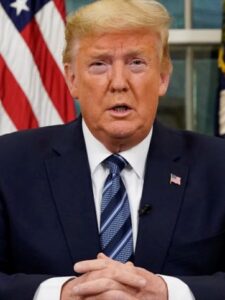 There is also a lot of talk about APPEARANCE. Who has the prettiest hair, and the most of it? Who has the nicest smile? This counted for a LOT during the Nixon-Kennedy debates. Remember that? We’ve had some really FAT presidents and really TALL presidents and some BALD presidents. What should POTUS look like? Dignified? Commanding? Trustworthy?
There is also a lot of talk about APPEARANCE. Who has the prettiest hair, and the most of it? Who has the nicest smile? This counted for a LOT during the Nixon-Kennedy debates. Remember that? We’ve had some really FAT presidents and really TALL presidents and some BALD presidents. What should POTUS look like? Dignified? Commanding? Trustworthy?
Do you believe EDUCATION is important? Where a person went to school, and what they studied. You’d think grades might be important, but those records are closed, for some of the candidates. Here’s what I found about college, alphabetically.
- BA Hanover College & JD Indiana University – Mike Pence
- BA Howard University & JD University of California, Hastings – Kamala Harris
- BA University of Delaware & JD Syracuse – Joe Biden
- BS Wharton School – Donald Trump
 RELIGION. Does that make a difference to you? That also factored large in the Kennedy-Nixon campaign. Kennedy was a CATHOLIC and non-Catholics had great fear that the Vatican would rule the US with a Catholic president. But remember, Kennedy was good looking enough to overcome that. Here’s the religious preferences the four claim.
RELIGION. Does that make a difference to you? That also factored large in the Kennedy-Nixon campaign. Kennedy was a CATHOLIC and non-Catholics had great fear that the Vatican would rule the US with a Catholic president. But remember, Kennedy was good looking enough to overcome that. Here’s the religious preferences the four claim.
- American Baptist; grew up attending Black Baptist Church and Hindu Temple, husband is Jewish – Kamala Harris
- Catholic, attends mass regularly with wife Jill – Joe Biden
- Evangelical Catholic; grew up Catholic, switched to Grace Evangelical megachurch – Mike Pence
- Presbyterian, doesn’t attend; wife Melania Catholic – Donald Trump
FAMILY. Spouse, kids? Some good stories here, as the years have gone by.
- 1966 – Joe Biden married Neilia Hunter, they had three children, Hunter, Beau and Naomi
- 1972 – Joe Biden was widowed when Neilia was killed in an automobile accident; daughter Naomi, age 1, died too
- 1977 – Donald Trump married Ivana Zelníčková, they had three children, Donald Jr, Ivanka, Eric
- 1977 – Joe Biden married Jill Jacobs, they had a daughter, Ashley
- 1985 – Mike Pence married Karen Batten, they had three children, Michael, Charlotte, Audrey
- 1992 – Donald Trump and Ivana Zelníčková divorced
- 1993 – Donald Trump married Marla Maples, they had a daughter, Tiffany
- 1999 – Donald Trump and Marla Maples divorced
- 2005 – Donald Trump married Melania Knauss, they had a son, Barron
- 2014 – Kamala Harris married Douglas Emhoff, he has two children, Cole and Ella, who call Kamala “Momala” rather than stepmom
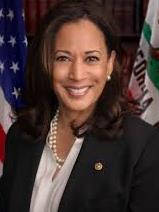 BIRTHPLACE. This has been a topic of note in previous campaigns. Where were they born? Where did they grow up? How many in their family? Which state can claim them?
BIRTHPLACE. This has been a topic of note in previous campaigns. Where were they born? Where did they grow up? How many in their family? Which state can claim them?
- California, Oakland. Kamala Harris was born here, grew up in Berkeley with one sister Maya; mother, Indian, was a biologist in cancer research; father, Jamaican, a professor of economics at Stanford.
- Indiana, Columbus. Mike Pence was born and raised here, along with five siblings; mother Irish ancestry, father, Irish/German descent, operated a group of service stations.
- New York, NYC Queens. Donald Trump was born and raised here with four siblings; mother born in Scotland, father German descent, real estate businessman.
- Pennsylvania, Scranton. Joe Biden was born here, grew up here and in Delaware with three siblings; mother Irish descent; father Irish, French, English, a used-car salesman.
POLITICAL OFFICE. Also bandied about – how many times has a candidate been ELECTED and SERVED in public office?
- 10 Joe Biden: 1 Delaware Councilman, 7 US Senator, 2 Vice President
- 5 Kamala Harris: 2 District Attorney, 2 State Attorney General, 1 US Senator
- 4 Mike Pence: 2 US Representative, 1 State Governor, 1 Vice President
- 1 Donald Trump: 1 President
NAME. What’s in a name? Names are good for name-calling, nick-naming, and campaign buttons, such as I Like Ike. Or Honest Abe. What is their actual spelled out name their Mama gave them? And what chemical reactions, or memories, or associations pop into your head when you see the words?
- Donald John Trump
- Joseph Robinette Biden
- Kamala Devi Harris
- Michael Richard Pence
I didn’t get any info on their favorite TV shows. That is a telling qualification too. Favorite foods…pets…hobbies…where they go on vacation…if they do. Knowledge of geography. Spelling skills.
» posted on Tuesday, July 7th, 2020 by Linda Lou Burton
Count Me!
 Linda Lou Burton posting from Little Rock, Arkansas – I’m signed up for regular updates from the U S Census Bureau because I love anything that gives me facts and figures to analyze. And as a dedicated student of family history, I rely heavily on Census records to “follow footsteps through time.” I was delighted a few years back when the Census was released that first had MY name on it! I was verified. There is something very satisfying about being counted. And 2020 is time to do it again.
Linda Lou Burton posting from Little Rock, Arkansas – I’m signed up for regular updates from the U S Census Bureau because I love anything that gives me facts and figures to analyze. And as a dedicated student of family history, I rely heavily on Census records to “follow footsteps through time.” I was delighted a few years back when the Census was released that first had MY name on it! I was verified. There is something very satisfying about being counted. And 2020 is time to do it again.
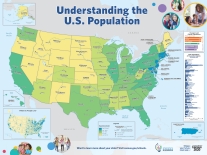 As you may know, every 10 years the United States counts its population. It’s a requirement, written into the Constitution. And the first count dates back to our first president, when U S Marshals conducted the census on horseback. It’s happened once a decade since then, as the country has continued to grow, and changes in our laws, our cultural norms and our attitudes have changed the focus of information gathered, and questions asked, in an effort to make sure everyone is counted.
As you may know, every 10 years the United States counts its population. It’s a requirement, written into the Constitution. And the first count dates back to our first president, when U S Marshals conducted the census on horseback. It’s happened once a decade since then, as the country has continued to grow, and changes in our laws, our cultural norms and our attitudes have changed the focus of information gathered, and questions asked, in an effort to make sure everyone is counted.
1790
The very first U S Census was conducted a year after George Washington took office. Every household in the original 13 states was visited, plus the districts of Kentucky, Maine, Vermont, and the Southwest Territory. The inquiries called for the name of the head of household, and the number of persons living in the household, as described:
- Free white male of 16 years and up (to assess the country’s industrial and military potential)
- Free white males under 16
- Free white females
- Slaves
The count according to that first census as of August 2, 1790 was 3,929,214.
1850
It was 1850 when the inquiries expanded to include every free person’s name, not just the head of household. Relationships were not listed, just names and ages, but additional “social statistics” included information on taxes, schools, crime, wages, and value of the estate.
Zachary Taylor was President of the United States on Census Day June 1, 1850. The U S had grown to 30 states by then, with a population count of 23,191,876.
1870
Census Day was June 1 in 1870 and Ulysses S Grant was President of our 37 United States.
After the Civil War, the decennial census questionnaires were redesigned to end the slave questionnaire. The schedules for the 1870 census were: General Population, Mortality, Agriculture, Products of Industry, and Social Statistics.
This was the first year a rudimentary tallying machine helped with the count, which added up to 38,558,371.
1880
Census Day was June 1 in 1880 and Rutherford B. Hayes was President of our 38 United States.
This census is a genealogists dream, because for the first time, relationships to “head of household” are listed: wife, son, daughter, and such things as lodger, or servant. Information about Alaska was included in this census, as well as all untaxed Indians within the jurisdiction of the United States.
The count in 1880 was 50,189,209.
1920
Census Day was January 1 in 1920 (more people would be at home in January, was the theory, than during the busy summertime) and Woodrow Wilson was President of our 48 states.
The format no longer asked about service in the Union or Confederate army or navy and there was no separate schedule for Indians in 1920. The instructions to enumerators did not require that individuals spell out their names. Enumerators wrote down the information given to them; they were not authorized to request proof of age, and the determination of race was based on the enumerator’s impressions.
Can you guess what our population count was a hundred years ago? 106,021,537!
2020
What will our 24th U S Census reveal?
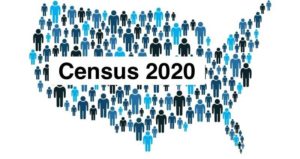 The 2020 Census counts every person living in the United States and five U S territories, Puerto Rico, American Samoa, the Commonwealth of the Northern Mariana Islands, Guam, and the U S Virgin Islands. Each home received an invitation to respond to a short questionnaire—online, by phone, or by mail—between March 12-20. No horseback! House calls only as necessary or requested.
The 2020 Census counts every person living in the United States and five U S territories, Puerto Rico, American Samoa, the Commonwealth of the Northern Mariana Islands, Guam, and the U S Virgin Islands. Each home received an invitation to respond to a short questionnaire—online, by phone, or by mail—between March 12-20. No horseback! House calls only as necessary or requested.
Why is it so important to respond?
The census provides critical data that lawmakers, business owners, teachers, and many others use to provide daily services, products, and support for you and your community. Every year, billions of dollars in federal funding go to hospitals, fire departments, schools, roads, and other resources based on census data. The results of the census also determine the number of seats each state will have in the U S House of Representatives, and they are used to draw congressional and state legislative districts.
The Census Bureau will never ask for your:
- Social Security number.
- Money or donations.
- Anything on behalf of a political party.
- Bank or credit card account numbers.
Additionally, there is no citizenship question on the 2020 Census.
If you haven’t responded yet, you can do so online, go here.
https://2020census.gov/en/what-is-2020-census.html
And for a little fun, test your knowledge of census history with this quiz. I did, and (brag, brag) I answered every question correctly. Hint: read the third paragraph of this post and you’ll ace the first question.
https://2020census.gov/en/what-is-2020-census/focus/history-quiz.html



